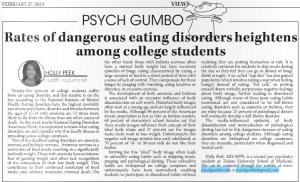Understanding Borderline Personality Disorder
The diagnosis of “borderline personality disorder” unfortunately carries with it much stigma. A “personality disorder” may carry negative connotations and the term “borderline” can conjure an image of an unstable person precariously straddling an imaginary line of what would be considered a “normal,” stable personality. BPD is a mental health issue just like anxiety and depression, yet it does not receive the same level of recognition.
Eight to 10 percent of those with the disorder commit suicide, which is a rate 50 times higher than in the general population. More than 70 percent of individuals with BPD will attempt suicide at least once, with rates peaking in individuals in their 20s and 30s.
Because of the dangerous consequences of BPD, it is important to increase understanding and encourage those with symptoms to seek therapeutic help, particularly in the vulnerable young adult population.
See how to recognize symptoms in my article appearing in The Hullabaloo.
More Information:
Colleges in Crisis: let’s talk about young adult mental health
The Tulane community has suffered several tragedies during the Fall 2014 semester, highlighting the need for awareness and advocacy for mental health issues on campus. Tulane isn’t alone in this mental health crisis. Colleges across the country struggle to meet the needs of their students and reduce the stigma surrounding mental illness. In order for us to come together as a community, we must talk about the unique mental health challenges college students face. Students must feel empowered to discuss mental health issues, while supporting and encouraging their peers to seek help when they need it.
See my article in The Hullabaloo to learn more about college mental health.
More Resources for College Mental Health:
Seasonal Affective Disorder on College Campuses
The days are getting shorter, the sunshine fades faster and the winter chill has arrived on Tulane’s campus. While the winter weather brings with it the anticipation of holiday vacations and festive cheer, it can also be a stressful time for college students as final exams draw near. For many, the change of season also brings a change of mood, known as seasonal affective disorder or major depressive disorder with a seasonal pattern. This disorder often begins in the late teens and early 20′s, with prevalence rates in college students ranging from 5 to 13 percent. Learn more about this seasonal phenomenon here.
The Hidden Harms of Hazing
Hazing is a practice often talked about on college campuses, particularly when students are considering which organizations to join. Despite strict rules banning this behavior, hazing still occurs regularly and is often considered a part of campus culture. The National Study of Student Hazing, including responses from 11,000 undergraduate students at 53 colleges and universities, found that more than half of college students involved in campus organizations experience hazing.
Why does this tradition still persist, despite strict rules against it? What are the hidden psychological dangers of hazing? What can college campuses do about it? Check out my latest article in The Hullabaloo here!
Hazing Resources:
National scandal brings dating violence into spotlight
The infamous elevator video of Ray Rice punching his current wife unconscious exploded in this month. Though many are aware that domestic violence exists, the harsh realities of this unpleasant topic are often avoided until some occurrence gains national attention, which forces us to have a conversation about reality. Realizing that someone you know may be a victim of domestic or dating violence or even be a perpetrator can be difficult, particularly in a young and vibrant campus community such as Tulane. In reality, however, abuse occurs in one in five college dating relationships.
Sound surprising? Click here to see my latest article in The Hullabaloo to learn more!
Additional Resources:
Heroin Gains Popularity Among College Students
 No longer considered a drug for the fringe substance abuser, heroin has gained more mainstream popularity, even among college students. Heroin is an opiate in the same class as painkillers such as lortab, percocet or oxycontin. Although it is more recognizable in its injectable form, it can also be smoked, ingested or snorted. The widely accepted drug culture on college campuses has made it socially acceptable to experiment with various drugs, including heroin. Experimentation is not always innocuous, however, as heroin is a drug with a potential for drug addiction and a highly uncomfortable withdrawal. Accidental overdoses are particularly deadly, as some students do not even realize what they may be snorting at a party is in actuality heroin. To learn more, check out my latest article in The Tulane Hullabaloo.
No longer considered a drug for the fringe substance abuser, heroin has gained more mainstream popularity, even among college students. Heroin is an opiate in the same class as painkillers such as lortab, percocet or oxycontin. Although it is more recognizable in its injectable form, it can also be smoked, ingested or snorted. The widely accepted drug culture on college campuses has made it socially acceptable to experiment with various drugs, including heroin. Experimentation is not always innocuous, however, as heroin is a drug with a potential for drug addiction and a highly uncomfortable withdrawal. Accidental overdoses are particularly deadly, as some students do not even realize what they may be snorting at a party is in actuality heroin. To learn more, check out my latest article in The Tulane Hullabaloo.
Sexual Assaults: The Silent Epidemic on College Campus
College students are particularly vulnerable to sexual assaults, with 19 percent of college women having experienced an attempted or completed sexual assault since entering college. Often called the “silent epidemic” on college campuses, sexual assaults are the most underreported crime, with 95 percent of attacks being unreported. These type of assaults take serious emotional tolls, with rape survivors being 13 times more likely to attempt suicide than people who have not been victimized. To learn more about the emotional tolls of sexual assaults and resources Tulane offers for survivors, check out my latest article in The Tulane Hullabaloo.
The Hookup Culture: does casual sex lead to depression, anxiety and low self-esteem?
It is no secret that casual sex is common on college campuses. In fact, studies have shown that 60 to 80 percent of college students have had some type of casual sex experience. Much research has focused on the link between casual sex and the negative effects it may have on a person’s mental health, such as contributing to depression, anxiety or low self-esteem. Much of this research is inconclusive or with mixed results. However, new research has indicated that it is not if a person participates in casual sex but the reasons behind their actions that contribute to negative emotional effects. To learn more, check out my latest article in The Tulane Hullabaloo.
Rates of eating disorders heighten among college students
Twenty-five percent of college students suffer from an eating disorder, and this statistic is on the rise according to the National Institute of Mental Health. Eating disorders have the highest mortality rate of any psychiatric disorder and females between the ages of 15-24 with anorexia are 12 times more likely to die from the illness than any other causes of death. Pathological dieting and poor eating habits have become normalized on college campuses, with students skipping meals or or doing “fad diets” so that they can go out to eat or binge drink at night. To learn more about eating disorders on college campuses, check out my article appearing in The Tulane Hullabaloo.
For more information, check out these links:
How to recognize warning signs of suicide in college
Suicide is the second-largest leading cause of death on college campuses, with approximately 1,100 students dying by suicide every year. Click my latest column below to learn more about suicide in college students, the risk factors and warning signs, and knowing how and when to seek support. Although the answer to preventing these tragedies is complicated, it can certainly start with educating ourselves about this tragic mental health issue.













